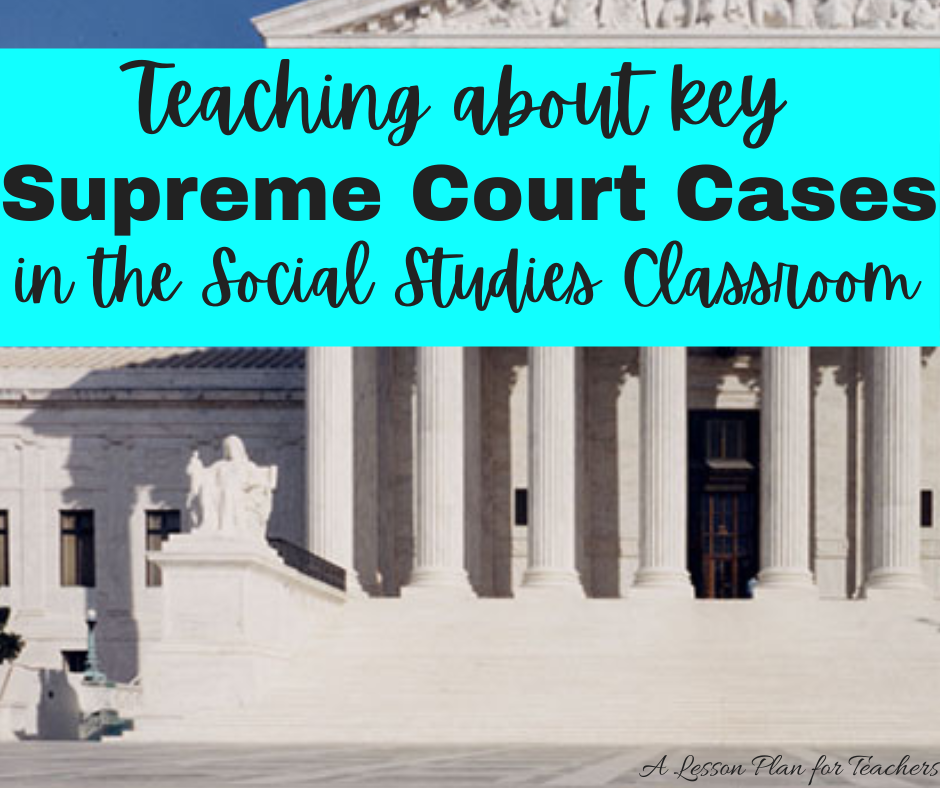Teaching Supreme Court cases is typically done in Government classes where students learn about the Constitution and the role of each governmental branch. Important cases are sometimes included in U.S. History classes to emphasize key events or eras in history, and often cases are referenced when addressing changes over time. However, current events are now demanding that we address Supreme Court cases and how the system works. Teaching this can be a challenge, but with the right strategy, you can do it easily in any class.

Teaching Supreme Court Cases
When we are teaching Supreme Court cases, it is vital to address the importance of the process, but it is not important to teach the actual process over and over. Students should learn about the courts and their role in Government classes, so reviewing this and moving into specific cases can be the key to keeping engagement in your other Social Studies, Current Events, or ELA classes.
Introduce cases where they are relevant in your lessons or tie them to current events happening in our world. These are the times when they will most connect for students, substantiating their importance. And current events in our country right now are prime for pulling in cases like Roe v. Wade or other Civil Rights cases that may be addressed by the court in coming sessions as they attempt to reshape America.
Strategies for Teaching Supreme Court Cases
When it comes to strategy for teaching Supreme Court cases, I have two that stand out. Primary Source Analysis and Inquiry-Based Learning Projects are my favorites. These are also versatile, so they can lead you in a number of different directions for direct or student-centered instruction.
Primary Source Analysis
Allowing students the opportunity to examine the actual cases is a great way to help them make connections to the content. As they read excerpts, they can relate to the original plaintiffs or make connections to the topics addressed by the courts. And analysis is a key way to break down the cases so they are more manageable for students. Do this in a THINK-PAIR-SHARE lesson or in Response Groups so students have a chance to discuss the topic at hand and the ruling to better understand the significance in history or in our modern world.
Inquiry-Based Learning
Anytime you can give students choice in the classroom, you are helping them to find a better connection to the content you are trying to teach. Using inquiry-based learning techniques with Supreme Court cases is a great way to let your students find where they want to dig deeper for a better understanding of the cases or of the role of the court. And let students work in pairs or small groups to complete their research stage or even the projects to encourage the discussion you want to foster when studying significant Supreme Court cases.
My Key Focus When Teaching Supreme Court Cases
To me, teaching about the Supreme Court and their role in our government is all about discussion. The Court should be discussing the cases and applying Constitutional law to make rulings relevant in modern society. They should be discussing the content of each case and evaluating how the American populous will be affected. And they should be examining the human impact of their ruling for future generations. That discussion should be mirrored by students when studying the cases in your classroom.
Use Response Group or Debate lessons to really let your students express their opinions on the cases. Let them share partisan positions. Let them consider how the cases will affect them and their peers and discuss those impacts. The lessons you teach on the important Supreme Court cases are really less about the cases themselves and more about how your students can see their role in shaping American of the future.
Resources for Teaching Supreme Court Cases
If you are looking for ready to use resources to teach the cases with the strategies mentioned above, take a look at the following:
- 10 Important Supreme Court Cases Analysis Bundle – This resource will help your students dig into the 10 most influential cases in American History. Teach them one case at a time or Jigsaw the cases so students learn about them all in one lesson.
- Individual Supreme Court Cases and Other Legislation – If you are looking to add in cases as you teach about topics or eras in American History, you can find the cases that will most relate and the legislation that supports the cases through this link.
- Inquiry-Based Learning Projects – Introduce your students to topics in history or significant people from history as they practice the skills of inquiry with these guiding lessons. My favorites are on the Civil Rights Movement and on Justice Ruth Bader Ginsburg.
- Abortion Issue Supreme Court Case Bundle – This set addresses recent current events issues with the 3 most significant abortion cases debated included for student analysis.

One Final Reminder
Don’t be afraid to address the big cases in your classes. They are our country’s history and should be taught in our classes. Let your students have the discussions they so desperately want to have about the topics in the news these days. It’s what they need to be doing to be better citizens as they become adults.
Teaching about the Supreme Court and the Cases doesn’t have to be challenging or frustrating for your or your students! Just find the right resources and the best strategies in which to teach them. Your students will soon understand the significance of the Court and their rulings on our daily lives. And, they will see the importance on their own lives – and that’s what maters most!
Happy Teaching!

Thanks for suggesting this. Decades ago, we read Supreme Court decisions in high school US Govt class. I think it was important to learn about the cases, but the lasting lesson was that we can and should comprehend technical writing (judicial decisions, statutes, scientific studies). I still have to look up word definitions and check the logic of the authors, but I know how to read for myself.
And that skill crosses over curriculums! I hope more students get the same practice. 🙂